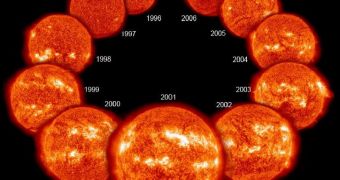Two instruments aboard the NASA Solar Radiation & Climate Experiment (SORCE) mission have been surveying the Sun's brightness levels daily since 2003, and experts have recently detailed findings based on these observations at the 2010 annual fall meeting of the American Geophysical Union.
The Total Solar Irradiance Monitor (TIM) and the Solar Irradiance Monitor (SIM) are the two instruments that have made the job of solar physicists a lot easier. They also assisted experts in gaining a better understanding of how the solar cycle operates.
One of the main reasons why these observations are being conducted is that climatologists want to keep track of space weather, while also analyzing how solar output variations influence our planet's climate.
TIM measures solar spectral irradiance, which means that it constantly keeps track of a certain part of the radiation spectrum the Sun emits, rather than the whole thing, as other instruments do.
SIM, on the other hand, has collected impressive datasets over the past 7 years, which have led solar experts to believe that the star is battering the Earth with massive levels of radiation even at the minimum stage of the solar cycle.
As you all know, our parent star functions in an 11-year cycle, with alternating periods called maximums and minimums, where solar activity levels peak and subside, respectively.
Thus far, experts believed that, during cycle minimums, the Sun was not releasing large amounts of radiation. However, SIM readings indicate that the exact opposite is true.
“We have never had a reason until now to believe that parts of the spectrum may vary out of phase with the solar cycle, but now we have started to model that possibility because of the SIM results,” explained expert Robert Cahalan.
He is a project scientist for the SORCE spacecraft, and also the head of the climate and radiation branch of the NASA Goddard Space Flight Center (GSFC), in Greenbelt, Maryland.
“We may have a lot more to learn about how solar variability works, and how the sun might influence our climate,” the expert said at the AGU meeting, which was held December 13-17 in San Francisco.
“If these SIM measurements indicate real solar variations, then it would mean you could expect a warmer surface during periods of low solar activity, the opposite of what climate models currently assume,” adds Gavin Schmidt.
He holds an appointment as a climate modeling specialist at the New York City-based NASA Goddard Institute for Space Studies (GISS).
Cahalan again underlined the importance of non-stop stellar surveillance, adding that “if we don't have the instruments up there to watch this closely, we could be arguing about spectral irradiance and climate for decades.”

 14 DAY TRIAL //
14 DAY TRIAL //